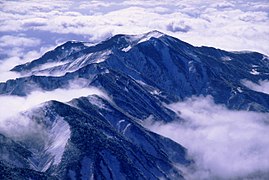| Mount Haku | |
|---|---|
| 白山 | |
 Mount Haku seen from Onanjimine Mount Haku seen from Onanjimine | |
| Highest point | |
| Elevation | 2,702.2 m (8,865 ft) |
| Prominence | 1,897 m (6,224 ft) |
| Listing | |
| Coordinates | 36°09′18″N 136°46′17″E / 36.15500°N 136.77139°E / 36.15500; 136.77139 |
| Naming | |
| English translation | White Mountain |
| Language of name | Japanese |
| Pronunciation | [hakɯ̥saɴ] |
| Geography | |
 | |
| Location | |
| Parent range | Ryōhaku Mountains |
| Topo map(s) | Geographical Survey Institute, 25000:1 白山, 50000:1 白山 |
| Geology | |
| Rock age | 300,000–400,000 years |
| Mountain type | Stratovolcano (active) |
| Last eruption | April to August 1659 |
| Climbing | |
| First ascent | Taichō in 717 |
Mount Haku (白山, Haku-san, "White Mountain"), or Mount Hakusan (commonly referred to as simply Hakusan), is a dormant stratovolcano in Japan. It is located on the borders of Gifu and Ishikawa, on the island of Honshu. Mount Haku is thought to have first been active 300,000 to 400,000 years ago, with the most recent eruption occurring in 1659. Along with Mount Tate and Mount Fuji, it is one of Japan's "Three Holy Mountains" (三霊山, San-rei-zan).
The mountain's tallest peak, Gozenga-mine (御前峰), is the one that gives the mountain its height of 2,702 m (8,865 ft). Along with Ken-ga-mine (剣ヶ峰), which is 2,677 m (8,783 ft), and Ōnanji-mine (大汝峰), which is 2,648 m (8,688 ft), the three peaks are considered "Mount Haku's Three Peaks" (白山三峰 Hakusan San-mine). Mount Bessan and Mount Sannomine are sometimes included and called "Mount Haku's Five Peaks" (白山五峰 Hakusan go-mine).
Because it is very prominent and clearly visible from the nearby coast, even after the surrounding mountains have lost their snow, Mount Haku still appears white, which is one explanation for the mountain's name, which means "white mountain." It is also the westernmost mountain in Japan that is over 2,000 m (6,562 ft) in height.
History and culture
Taichō, a mountain Shugendo monk, first climbed Mount Hakusan in 717. For hundreds of years, people have come to Haku for prayers (白山信仰 Hakusan Shinkō). A branch shrine of Shirayama Hime Shrine, which served as the Ichinomiya for Kaga Province, is on the mountain. The Shirayama Hime Shrine is the main shrine (総本社, sō-honsha) of approximately 2,000 Hakusan shrines (白山神社, Hakusan jinja) in Japan. In 1980 an area of 48,000 ha was designated a UNESCO Man and the Biosphere Reserve.
Nature
Mount Haku was designated as a quasi-national park in 1955. It became a national park in 1962 and was renamed Hakusan National Park. Because the central part of the mountain has much precipitous terrain, there are very few roads and, as a result, little human intrusion into the area. Also limiting human intrusion is the designation of the park as a Wildlife Protection Area, covering over 38,061 ha. The park stretches beyond the mountain's borders into Toyama Prefecture.
Geological features
The area surrounding Mount Haku is one of the few in Japan that contains outcroppings from the Jurassic period of the Mesozoic era. Many of Japan's typical examples of dinosaur fossils were found in this area. One of the major rock outcrops is in the Kuwashima area and is known as the "Kuwashima Fossil Wall" (桑島化石壁 Kuwashima Kasekikabe).
Because the mountain is a dormant volcano, it is well known for its many onsen.
Flora
Mount Haku is known for its diverse plant life. Along the Sabō Trail, after passing the Jinnosuke Lodge, alpine plants are found, including the chocolate lily, which is Ishikawa's prefectural plant.
There are many alpine plants which have Hakusan in their name. These include Primula cuneifolia (Hakusan Kozakura), Anemone narcissiflora (Hakusan Ichige), Dactylorhiza (Hakusan Chidori), Geranium yesoemse (Hakusan Fuuro) and Rhododendron brachycarpum (Hakusan Shakunage). These plants can be found on many mountains throughout Japan, but they were first discovered and named along the older hiking trails leading to Hakusan Shrine.
| Chocolate lily (Kuro Yuri) |
Primula cuneifolia (Hakusan Kozakura) |
Anemone narcissiflora (Hakusan Ichige) |
Dactylorhiza aristata (Hakusan Chidori) |
|---|---|---|---|

|

|

|

|
Fauna
The golden eagle, Ishikawa's prefectural bird, lives on the slopes of Mount Haku. The rock ptarmigan, Gifu's prefectural bird, used to live on the slopes as well. During the Meiji period, the entire population of ptarmigan on the mountain disappeared; however, sightings of the grouse have recently been recorded by local residents.
Hiking trails
The three most used hiking trails are the Kankō Trail (観光新道 Kankō Shinmichi), the Sabō Trail (砂防新道 Sabō Shinmichi) and the Hirase Trail (平瀬道 Hirase-dō). Both the Kankō Trail and the Sabō trail originate in the city of Hakusan, Ishikawa Prefecture, but the Hirase Trail starts from the Ōshirakawa Dam (大白川ダム) in Gifu Prefecture.
Because the area is protected as a national park, very few trails have been made on the mountain. Though the trails listed above are easy enough to hike up and down in one day, other trails can take two or three days because of the uncleared trails and rough terrain.
Gallery
-
Top of Gozengamine (Mount Haku) and Ōnanjimine
-
 Hakusan Shrine at Murodo and Gozengamine
Hakusan Shrine at Murodo and Gozengamine
-
 Volcanic crater (Midoriga-ike)
Volcanic crater (Midoriga-ike)
-
 Mount Haku in each season
Mount Haku in each season
-
Mount Haku from Midagahara
-
Kengamine Peak from Gozengamine Peak
-
 Mount Haku from east of Mount Hideri
Mount Haku from east of Mount Hideri
-
 Mount Bessan from the top of Gozengamine
Mount Bessan from the top of Gozengamine
See also
- Hakusan National Park
- Ryōhaku Mountains
- List of volcanoes in Japan
- List of mountains in Japan
- Taichō
References
- ^ "Japan Ultra-Prominences". Peaklist.org. Retrieved 2015-01-01.
- 白山のなりたち、信仰の歴史を簡単に紹介します。 [A brief introduction to the origins of Mt. Hakusan and the history of the faith.]. Hakusan Wide Area Tourism Promotion Council Website (in Japanese). Archived from the original on 21 September 2010.
- ^ UNESCO Biosphere Reserve Information: Mount Hakusan. UNESCO. Accessed May 16, 2008.
- "Biosphere Reserve Information - Mount Hakusan". UNESCO. Retrieved 29 April 2011.
- A Statistical Guide to Gifu Prefecture 2007 Archived 2009-03-25 at the Wayback Machine. Gifu Prefecture. Accessed May 16, 2008.
External links
- Hakusan - Japan Meteorological Agency (in Japanese)
- "Hakusan: National catalogue of the active volcanoes in Japan" (PDF). - Japan Meteorological Agency
- Hakusan - Geological Survey of Japan
- "Hakusan". Global Volcanism Program. Smithsonian Institution. Retrieved 2021-06-24.
| 100 Famous Japanese Mountains | |||||||||
|---|---|---|---|---|---|---|---|---|---|
| Hokkaidō | |||||||||
| Tōhoku region Jōshinetsu region |
| ||||||||
| Kantō region | |||||||||
| Chūbu region |
| ||||||||
| Western Japan | |||||||||
| |||||||||
| Shirayama Hime Faith | ||
|---|---|---|
| Main Deities |
|  |
| Head Shrines | ||
| Branch shrines | ||
- Volcanoes of Honshū
- Mountains of Gifu Prefecture
- Mountains of Ishikawa Prefecture
- Mountains of Fukui Prefecture
- Two-thousanders of Asia
- Biosphere reserves of Japan
- Cultural landscapes of Japan
- Volcanoes of Gifu Prefecture
- Volcanoes of Ishikawa Prefecture
- Volcanoes of Fukui Prefecture
- Potentially active volcanoes
- Pleistocene stratovolcanoes
- Pleistocene Asia
- Cenozoic Japan
- Sacred mountains of Japan
- Shugendō
- Highest points of Japanese national parks